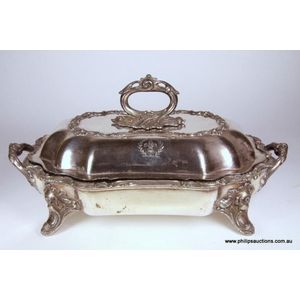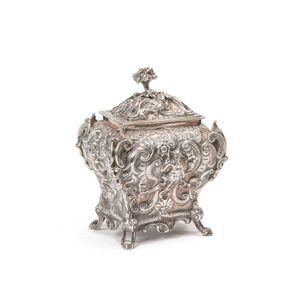Embossed Sterling Silver Soup Tureen with Lion's Head Handles
You must be a subscriber, and be logged in to view price and dealer details.
Subscribe Now to view actual auction price for this item
When you subscribe, you have the option of setting the currency in which to display prices to $Au, $US, $NZ or Stg.
- Sterling Silver - Sterling silver is a mixture of 92.5% pure silver and 7.5% of another metal, usually copper. Fine silver is 99.9% pure silver, and is relatively soft and the addition of the very small amount of copper gives the metal enough strength and hardness to be worked into jewellery, decorative and household objects.
- Chasing - The method of decorating gold and silver objects using a punch and hammer so that the design appears in relief. Flat or surface chasing is done from the front giving the item definition, but not cutting into the metal.
Chasing is the opposite technique to repousse, but an object that has repousse work, may then have chasing applied to create a finished piece. - Hallmarks - A mark stamped on articles of precious metals in Britain, since the 14th century, certifying their purity. It derives its name from the Guild Hall of the Goldsmiths' Company, who recieved its Charter in 1327 giving it the power to assay (test the purity) and mark articles of gold and silver.
The hallmark will consist of several marks, including the:
- silver standard mark, indicating the purity of the metal. Sterling silver is .925 pure silver.
- the city mark indicating the city in which it was assayed eg London, Birmingham, York etc.
- the date mark, usually a letter of the alphabet in a particular font and case,
- a duty mark, indicating whether duty had been paid to the crown, and only in use from 1784 to 1890
The piece may include an additional mark, the maker's mark, although not forming part of the hallmark, will be located in the vicinity of the hallmarks.
Sometimes silver plated items will bear faux hallmarks, often confusing those not familiar with silver markings. - Embossed / Repousse - Embossing, also known as repousse, is the technique of decorating metal with raised designs, by pressing or beating out the design from the reverse side of the object.It is the opposite of chasing, where the decoration is applied from the front. An embossed or repoussed object may have chasing applied to finish off the design.
- George Iii - George III (1738 - 1820) was King of Great Britain and Ireland from 1760 to 1820.
- Tureen - Circular or oval, deep, covered bowl, used from the early 18th century for serving soup, sauce, vegetables or stew. As well as silver, tureens are also made in porcelain, pottery, and silver plate, Sauce tureens are smaller, plainer versions. The name derives from the French "terrine", meaning 'earthen vessel',
This item has been included into following indexes:
Visually similar items

A large George IV sterling silver oblong soup tureen and cover by John & Henry Lias, London 1827, 24 cm high, 36 cm wide, 24 cm deep, 4,750 grams

A Victorian Sheffield plate vegetable tureen, 19th century, a substantial shaped rectangular tureen well cast in the rococo revival manner, having a deep warming base, a fitted shallow dish and domed lid with a removable foliate form handle, bearing a fleu

A George IV sterling silver Chinoiserie tea caddy by John Wintle, London circa 1825, 17 cm high, 585 grams

An Imari porcelain and bronze mounted oval jadiniere Japanese with French Mounts 19th century, 33 cm high, 47 cm wide, 28 cm deep
